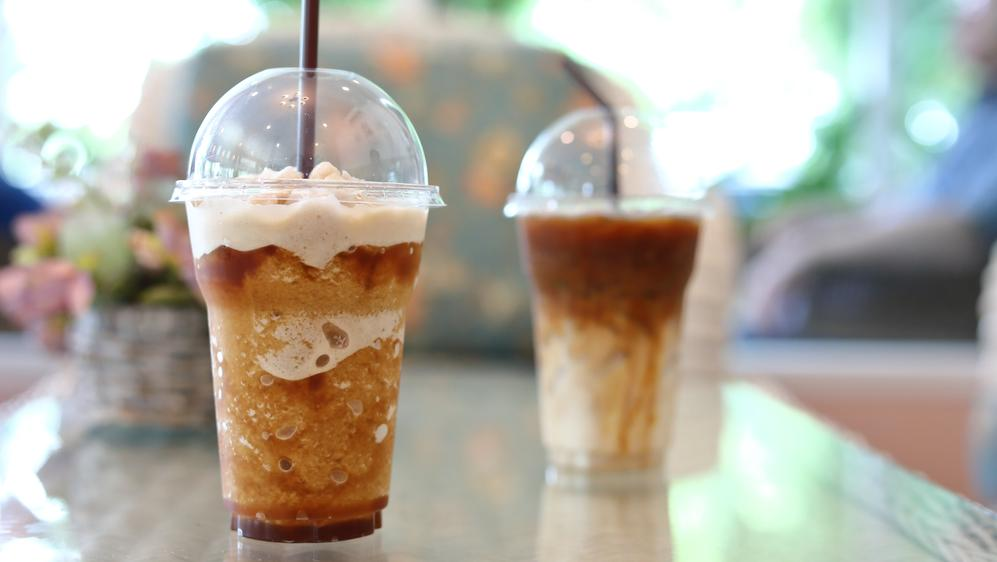The Real Reason Coffee Is More Expensive Now
There are tons of hidden factors that inform the price of a Starbucks latte.
"A cup of coffee used to cost a dollar, tops! What gives with these prices?"
This is what many of our elders have been grumbling since at least the mid-'90s, when Starbucks began its ascent toward becoming America's second biggest quick service chain. However, "a cup of coffee" as described by such grouches is simply a different beast entirely: thin, scorched drip coffee dispensed at a gas station or poured from a carafe at the lunch counters of yore. Of course coffee is more expensive now—it's become steadily more gourmet and elaborate, requiring more materials and labor to produce. And a recent deep dive by Emily Stewart at Vox explains what has contributed to the climbing costs of our favorite coffee drinks.
In an article titled "Why your $7 latte is $7," Stewart acknowledges that coffee is indeed getting more expensive, but the reason is not solely inflation, nor is it supply chain disruptions, as has been the case with so many tasty items since 2020. There are tons of different market forces informing the price of, say, a Pumpkin Spice Latte—here's a brief rundown of some contributing factors, as laid out by Vox.
Coffee beans and dairy
Let's start with the big one: the beans. Coffee is a commodity, a valuable agricultural product whose price can fluctuate year to year. Right now, the price of coffee beans is not as high as it has been in the recent past; last year, beans were at peak prices. But a business like a cafe can't be constantly changing its prices to reflect the latest cost of these commodities, so the cost of a beverage is often designed to withstand some market fluctuation and keep business margins steady. Just because coffee beans lower in price doesn't mean the cost of the drink will come back down in kind. Dairy, another commodity, is included in this calculus, too, which is part of why a cafe au lait costs more than a black coffee.
Interestingly, Vox notes that certain drinks can also cost more depending on the process by which they're made. Cold brew coffee, for example, requires a greater volume of coffee grounds to be steeped for a longer time, so it commands a higher price.
Coffee cups, lids, and sleeves
Beyond the ingredients involved in your drink, there are the materials needed to serve it to you, including paper cups, plastic cups, plastic lids, cardboard sleeves, and straws. This 2021 feature from Quartz (also owned by The Takeout's parent company, G/O Media) illustrates the cost of these materials for any establishment doing takeaway business—and at Starbucks, you get the disposable cup regardless of whether you drink your coffee on site or leave with it.
While Starbucks has recently experimented with more sustainable options, it's unlikely that the company will ever phase out these disposable accoutrements, so it's stuck paying for them. Whenever those materials become more expensive to produce, the consumer inevitably shoulders some of that cost.
Rent and utilities
Our coffee isn't prepared for us in a vacuum. It's made wherever the cafe pays rent to set up shop, and in pricier areas of town, location will factor into the cost of the coffee. This is true with all quick service businesses, of course; look no further than the infamous $28 Taco Bell lunch order to understand how our bill can be influenced by rent prices. Since rent and utilities are considered fixed costs, they aren't likely to spike menu prices unexpectedly. But they're certainly baked into the experience of purchasing a cold brew.
Fuel surcharges
Coffee shops get their inventory from suppliers, who have to ship items across large distances, most often via the American trucking system. That means gas prices are factoring into your cup of coffee, too.
"Even thinking back to when everyone was up in arms about how high the price of gas was getting, that was something where our vendors added fuel surcharges, and those fuel charges haven't gone away," one coffee shop owner told Vox.
Labor costs
Workers, thanks in large part to union solidarity, have begun to command improved wages within the industry, and charging more for a cup of coffee is one way for businesses to defray the higher payroll costs. Still, the last thing any of us should do is blame workers for the rising price of coffee, for two reasons: One, our appetite for gourmet craft coffee drinks can only be satisfied by a fully staffed and justly accommodated barista workforce, and two, the price of these types of drinks has never sat well with the American people and probably never will. That's why the ol' Grouch Complaining About Fancy Coffee archetype exists in the first place.
Ultimately, our handcrafted coffee drinks will never come cheap, but it's worth knowing why they cost what they do. And hey, if you're looking for a cheaper alternative, you can always learn to appreciate the delights of black coffee.
